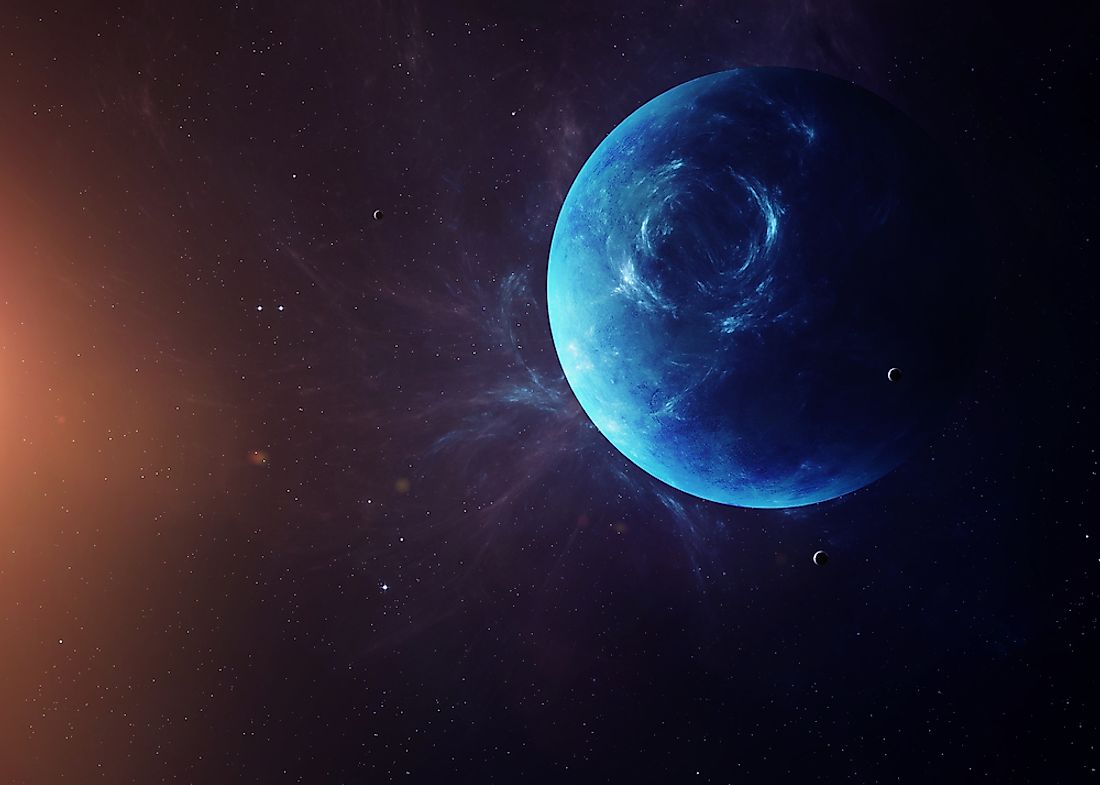Neptune: the Blue Planet

Neptune is the furthest planet from the sun at an average distance of 4.50 billion kilometers or 30.1 AU. The planet is a gas giant and is the fourth largest in the solar system. Due to its great distance from Earth, much about the planet remains a mystery. However, there few facts established about the giant blue planet, which we will outline below.
9. Have We Ever Landed on Neptune?
Voyager 2 remains the only space probe to conduct a close flyby on Neptune. Voyager 2 reached Neptune in 1989 while on its solar-system voyage and offered some candid images of the planet. The space probe was closest to the gas giant on August 25th, 1989 being about 3,000 kilometers of the planet’s North Pole. The close flyby was also critical in offering astronomers great insight about Neptune with Voyager 2 confirming the presence of a magnetic field around the planet which was similar to that surrounding Uranus. The close encounter also showed that Neptune had more than one ring surrounding the planet and it also confirmed the existence of an enormous rotating storm system known as “Neptune’s Great Dark Spot,” which was earlier thought to be a cloud. When relaying the information from Neptune, the signals from the Voyager 2 took 245 minutes to reach the earth. Other explorations on Neptune are scheduled to begin in the mid-21st century.
8. How Long is Neptune's Orbit?
Due to the immense distance between Neptune and the sun, the planet has the widest orbit of any planet in the solar system. The immensely wide orbit, compounded by Neptune’s relatively slow orbital speed of 5.43 kilometers per second, causes the planet to complete one revolution around the sun in an astonishing 165 earth years. Neptune’s orbit around the sun averages at 2,798.656 million miles or 30.11 AU (astronomical units). However, due to the planet’s 0.009456 orbital eccentricity, this distance ranges between 2,771 million miles or 29.81 AU and 2,821 million miles or 30.33 AU.
7. Who Discovered Neptune?
The identity of the first person to discover Neptune has been a topic of contention in the history of astronomy. Most astronomers believe that the existence of Neptune was established mathematically by Le Verrier in 1845 before its empirical discovery using a telescope. However, Galileo Galilei was the first person to observe Neptune using a telescope in 1613 and later recorded his observation in his notes. However, Galileo Galilei’s simple telescope showed Neptune having slow motion causing the astronomer to mistake Neptune to be a fixed blue star.
6. Hot Thermosphere
Neptune’s thermosphere is found between its exosphere and its stratosphere. Despite being the furthest planet from the sun in the solar system, Neptune’s thermosphere has an unusual characteristic of high temperatures which reach about 477 oC. These temperatures are similar to the temperatures recorded on Venus, the second-closest planet in the solar system. Many theories have come up attempting to explain how heat is generated on a planet so far from the sun but none have been proven.
5. Does Neptune Have Rings?
Neptune is not a likely contender of a planet possessing a ring with Saturn being the most famous planet owning spectacular rings. However, Neptune does have a ring system made up of five rings: Arago, Galle, Lassell, Le Verrier, and Adams, each named after astronomers who were instrumental in the planet’s discovery. Neptune’s ring system is made up of rock fragments and dust. The ring system is relatively young - much younger that Uranus’ ring system - and is believed to be a result of the collision between the planet’s moons. Neptune’s ring system is relatively dull with astronomers believing that it is made up of organic compounds.
4. How Did Neptune Get Its Name?
The tradition of naming planets began in ancient Rome where the Romans named the visible planets after their gods. After the discovery of the telescope, more planets were discovered and the tradition of naming them after Roman gods continued. Neptune has a distinctive blue color which is similar to the blue color of the Earth’s oceans when viewed from space. Astronomers decided to name the planet after Neptune, the god of the sea and allocated the planet a stylized version of the Roman god’s trident as its astronomical symbol.
3. How Large is Neptune?
Neptune is the fourth largest planet in the solar system, but it is the third most massive planet, exceeding Uranus in mass. The gas giant has a mass of 1.0243*1026 Kgs which when compared to the Earth’s 6*1024Kgs mass translates to Neptune having 17 times the mass of the Earth. While the planet might seem significant, it is small when compared to other bigger gas giants with Neptune’s mass being equivalent to 5% of the mass of Jupiter.
2. How Many Moons Does Neptune Have?
Astronomers have so far identified 14 natural satellites (moons) revolving around Neptune. The largest of the moons is Triton which was discovered soon after the discovery of Neptune. Triton is the only object revolving around Neptune massive enough to exist as a spheroid and its mass accounts for 99.5% of the total mass orbiting Neptune. Other moons include Nereid, Proteus, Thalassa, Galatea, Naiad, Despina, and Larissa. The most recently discovered Neptune moon is known as S/2004 N 1 which is also the smallest moon yet.
1. Furthest Planet from the Sun
Since its discovery in 1930, Pluto was known as the furthest planet from the earth, but the General Assembly of the International Astronomical Union in 2003 came up with a new definition of a planet stating a planet should “have sufficient mass to overcome its compressive strength and achieve hydrostatic equilibrium." The definition effectively demoted Pluto from its planetary status. Neptune is currently the furthest known planet from the earth.











